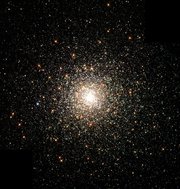Globular cluster
|
|
A globular cluster is a spherical bundle of stars (star cluster) that orbits a galaxy as a satellite. Globular clusters are very tightly gravitationally bound, which gives them their spherical shape, and extremely dense (in relative terms) towards their core.

| Contents |
General information
Globular clusters are composed of hundreds of thousands of old stars, similar to the bulge of a spiral galaxy but confined to a volume of only a few cubic parsecs. Globular clusters are fairly numerous; there are about 150 currently known globulars of the Milky Way (with perhaps 10-20 more undiscovered), and larger galaxies like Andromeda have more (Andromeda may have as many as 500). Some giant elliptical galaxies (e.g., M87) may have as many as 10 thousand globular clusters. These globular clusters orbit the galaxy out to large radii, 100 kiloparsecs or more.
With a few notable exceptions, each globular cluster appears to have a definite age. That is, all the stars in the cluster formed at virtually the same time. It was the recognition of this fact, studying Hertzsprung-Russell diagrams of globulars, that led to the earliest understanding of stellar evolution.
Some globular clusters (like Omega Centauri in our Milky Way, and G1 in M31) are truly massive clusters, with several million times the mass of our Sun. Such globular clusters may be the former nuclei of galaxies that once orbited their host galaxy, but were totally engulfed and tidally stripped of their stars save for the dense nucleus. However, most globular clusters are much smaller, having on the order of a few hundred thousand stars.
In many galaxies (especially massive elliptical galaxies) there appear to be two populations of globular clusters, which appear to be of similar ages (nearly as old as the universe itself) but of different metal abundances. These subpopulations are generally known as "metal-poor" and "metal-rich", although the metallicities of the metal-rich clusters are generally less than that of the Sun. Many scenarios have been suggested to explain these subpopulations, including violent gas-rich galaxy mergers, the accretion of dwarf galaxies, and multiple phases of star formation in a single galaxy. In our Milky Way, the metal-poor clusters are associated with the halo and the metal-rich clusters with the Bulge.
It was through the study of globular clusters that the Sun's position in the Milky Way galaxy became known. Until the 1930s, it was thought that the Sun was near the middle of the galaxy because the distribution of stars in the observable Milky Way appeared uniform. However, the distribution of globular clusters was strongly asymmetric. Assuming a roughly spherical distribution of globular clusters around the galaxy's center, one can estimate the direction from the Sun to the galactic center. By further estimating the distances to the clusters, the distance of the Sun to the galactic center can be estimated as well. It thus became clear that the part of the Milky Way seen from Earth was only a small part of the total galaxy, most of which was obscured by gas and dust.
Although most globular clusters are very old, some young clusters appear to form in a variety of star-forming events at the present day. These include major spiral-spiral galaxy mergers, starbursts in dwarf galaxies, and even in quiescent disk galaxies.
Globular clusters have a very high star density, and therefore close interactions and near-collisions of stars do sometimes occur. Some exotic classes of stars, such as blue stragglers, millisecond pulsars and low-mass X-ray binaries are much more common in globulars.
See also
References
General resources
- NASA Astrophysics Data System (http://adswww.harvard.edu/) has a collection of past articles, from all major astrophysics journals and many conference proceedings.
- SCYON (http://astro.u-strasbg.fr/scyon/) is a newsletter dedicated to star clusters.
- MODEST (http://www.manybody.org/modest/) is a loose collaboration of scientists working on star clusters.
Books
- Binney, James; Tremaine, Scott (1987). Galactic Dynamics, Princeton University Press, Princeton, New Jersey.
- Heggie, Douglas; Hut, Piet (2003). The Gravitational Million-Body Problem: A Multidisciplinary Approach to Star Cluster Dynamics, Cambridge University Press.
- Spitzer, Lyman (1987). Dynamical Evolution of Globular Clusters, Princeton University Press, Princeton, New Jersey.
Review Articles
- Elson, Rebecca; Hut, Piet; Inagaki, Shogo (1987). Dynamical evolution of globular clusters. Annual review of astronomy and astrophysics 25 565. NASA ADS (http://adsabs.harvard.edu/cgi-bin/nph-bib_query?bibcode=1987ARA%26A..25..565E)
- Meylan, G.; Heggie, D. C. (1997). Internal dynamics of globular clusters. The Astronomy and Astrophysics Review 8 1. NASA ADS (http://adsabs.harvard.edu/cgi-bin/nph-bib_query?bibcode=1997A%26ARv...8....1M)
External links
- Globular Clusters (http://www.seds.org/messier/glob.html), SEDS Messier pages
- Milky Way Globular Clusters (http://www.seds.org/~spider/spider/MWGC/mwgc.html)
- Catalogue of Milky Way Globular Cluster Parameters (http://physun.physics.mcmaster.ca/Globular.html) by William E. Harris, McMaster University, Ontario, Canada.
- A galactic globular cluster database (http://www.mporzio.astro.it/~marco/gc/) by Marco Castellani, Rome Astronomical Observatory, Italy.de:Kugelsternhaufen
es:Cúmulo globular fr:Amas globulaire it:Ammasso globulare ja:球状星団 nl:Bolvormige sterrenhoop pl:Gromada kulista fi:Pallomainen tähtijoukko sv:Klotformad stjärnhop
